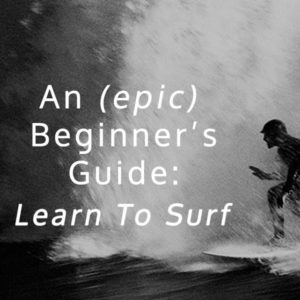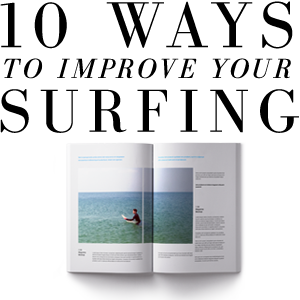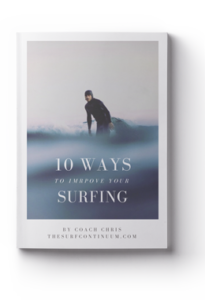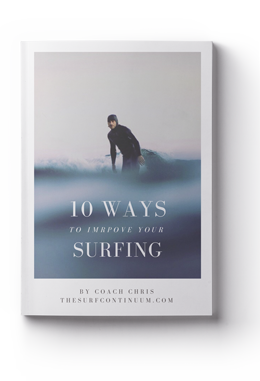Prefer listening to reading? We covered this article in a podcast episode of the same title:


Hey readers! Are you learning how to surf? But are you a beginner or a big old kook? Use this list to help you avoid becoming the dreaded “K” word. Of course, complete avoidance isn’t realistic, but with a little education on surfing basics you can earn yourself a little bit of respect.
1. Riding Waves is Easy
If you’re here to learn about surfing, the first thing you should know is:
Standing on a moving surfboard and riding a wave is pretty damn easy.
That’s why you see 99% of surf instructors holding their students board and pushing them into waves.
Riding a wave is the easy part and it makes both student and instructor feel great when you leave your hour “lesson” smiling and feeling like a surfer.
Now that you’re all fired up on how easy is it to ride waves, here’s the catch. While riding waves is totally easy–learning how to catch waves is a lot harder. Especially when you need to deal with crowds.
“Learning How to Catch Waves is Much Harder“
Surf media is almost entirely composed of pictures and videos showing people riding waves, so much so that we seem to forget the most impressive and challenging part of being a surfer is that you must be skilled enough to catch those waves in the first place.
As bands of energy come in towards the beach (that’s what waves are), their shape, speed, and size are constantly changing and shifting based on the local conditions like tide and wind, and submarine factors like bathymetry (the depths and contours of the ocean floor). You can learn more about reading waves here.
A surfer is a person who is constantly evaluating and studying the waves every moment as they develop. Their fundamental skill-set is the vehicle that carries them to the right place, with the right speed, at the right angle, and the right time to catch that wave.
Learning to do that is what ultimately leads to the easy part of surfing…riding the wave
And it all starts by knowing and practicing your fundamentals.
2. Surfing Fundamentals
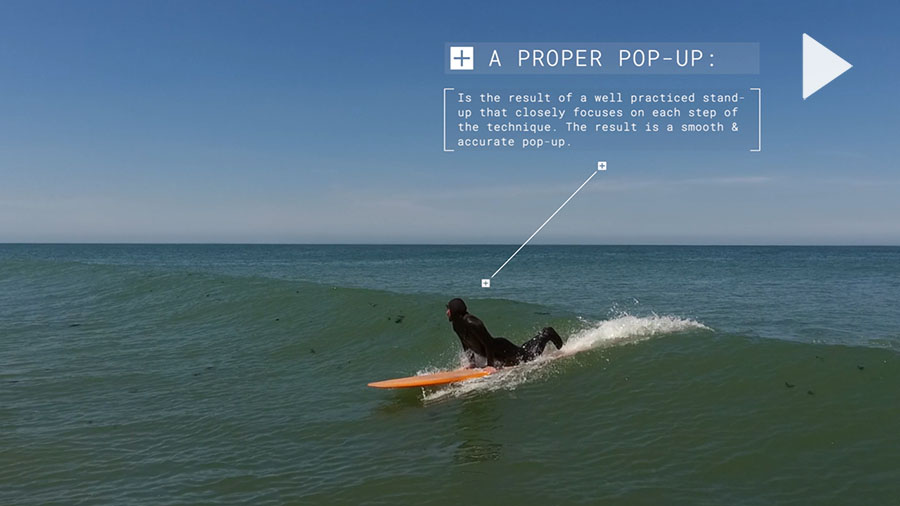
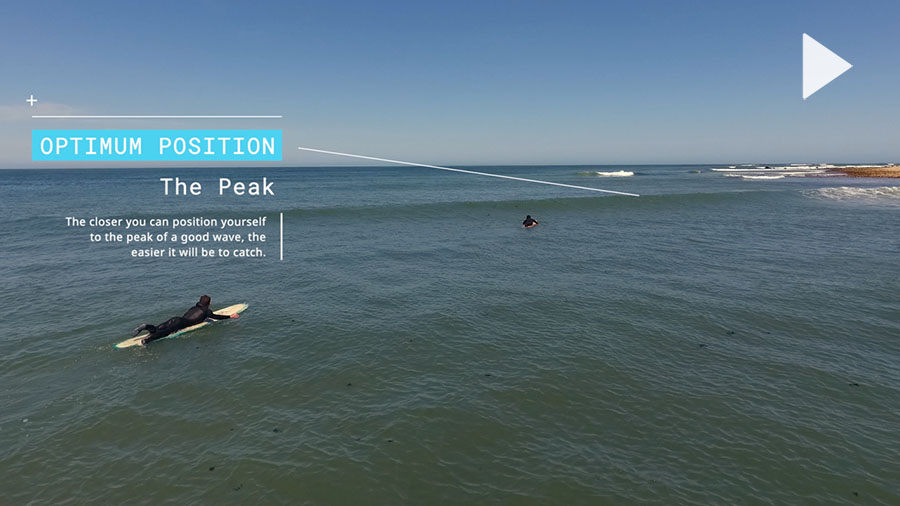
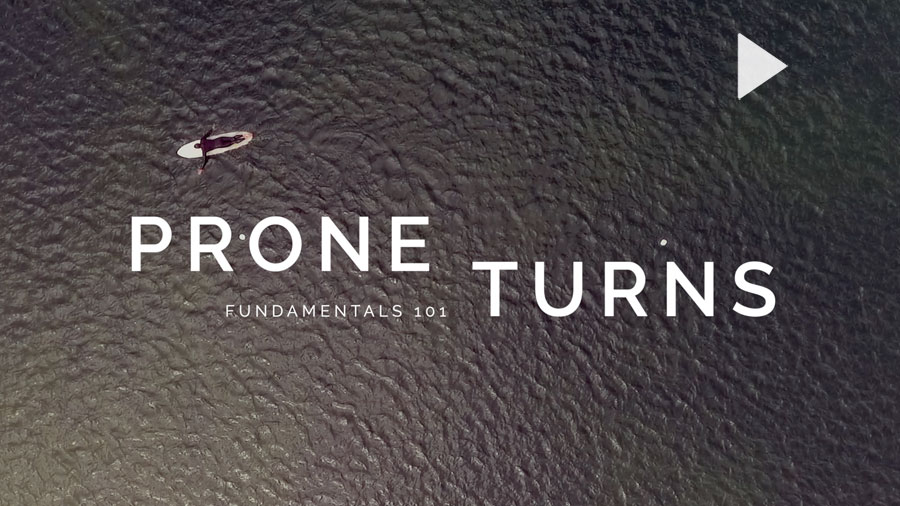
(Some featured images from our library of online videos)
You need them. The stronger they are the better. Every beginner should be practicing surfing fundamentals. It’s a pillar of our education, and the reason we made an epic online membership program based on them (you check it out for free).
Wanna know why?
Because like we said in our first point:
Riding waves is easy. Catching waves is harder.
The only way to be become a surfer who can catch any wave easily is to strengthen your surfing basics. No matter how long you surf. Forever improve your fundamentals.
If your learn to surf journey begins with teaching yourself the 3 most basic topics any surfer needs (paddling technique, board control skills, and a proper stand-up technique), you will be well prepared to practice learning how to catch waves.
3. Choosing the Right Gear For You
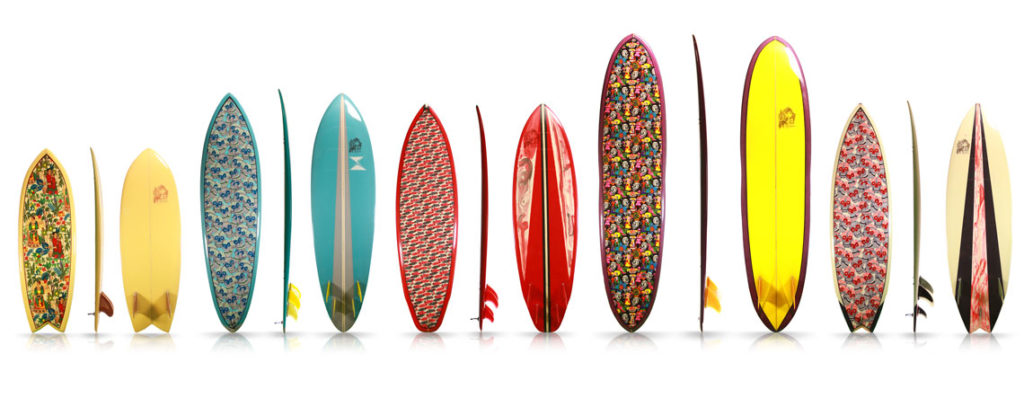
- Surfboard – The ideal surfboard for you is dependent on your size, experience, and goals. There is no ‘one size fits all’ beginner’s board for the person who wants to learn to surf. Therefore you must do your best to be thorough here because the right answer is different for everyone. Ideally you would borrow or rent some boards in the 8-9 foot range, but don’t be afraid to ask better surfers. Ask surf shop owners (our recommendations for the New York area listed below). Talk to your surf instructor. Ask other beginners who are a similar size as you about their board. My only advice in this area would be, don’t just buy the biggest board you find. This is a common recommendation made to beginners. A bigger board will be easier (at first) to paddle and balance on, but as you learn to perfect your fundamentals everything else in surfing (including the fundamentals) becomes harder with a huge surfboard. Carrying it, controlling your board in the water, getting through white water, taking-off on steeper waves is all made more difficult by using a bigger board than necessary. There is a good size for you out there, and you can find it with a bit of diligence.
- Wetsuit Gear – If you live in a cold place don’t be afraid to suit up and start learning. A Vissla 5/4 has been my suit of choice this past winter season and has held up beautifully. Nearly all wetsuits are good when they’re new, but time is the true test of a wetsuit, and Vissla is so far passing with flying colors. Discover the temperature of the water at your local beach so you can go to Vissla’s website knowing which wetsuit to buy. Every wetsuit description has the appropriate water temperature for that suit listed.
- Leash – Make sure to get a leash that is at least as long as your board. Here’s a great resource for more info on leashes.
- Fins – Can I be honest with you? You don’t need to worry too much about your fins, or fin setup. Whatever your fin setup is, you’ll become accustomed to the feeling that setup offers and get it dialed in. By now, fin development has been going on for years and the industry has pretty much figured out what works and what doesn’t. So don’t get too hung up on it.
- Roof Racks and Straps – Most beginners start learning to surf on boards too big to fit inside of the car (the best way to protect your board when traveling by car). That means you’ll need to figure out a rack and strap setup. There are many roof rack options out there, and you’ll need to do research based on the type of car you have. But the number one thing you should leave this article knowing about strapping your board to the roof is, you should keep the board in a proper travel bag, or at the very least a board sock. Always lay the board on the racks deck down, fins up. This next tip always sparks a debate, but its our opinion that the fins should be forward. Our reasoning and main defense for this opinion is as follows: in the event your straps loosen and your board begins to slip back as you drive, eventually the fin will reach the first strap and get caught there preventing the board from entirely slipping out of the straps and flying away.
- Wax – There two general kinds. Base coat, and top coat. Base coat is all the same and should be used on your bare board as your first layer of wax. Use a good amount of base coat, at least half a block, but definitely the whole block for long boards. Afterwards, put a light coat of temperature specific wax for the temperature of water you’ll be in.
We realize it can be daunting to walk into a surf shop to get any one of these things, especially since once you get there you’ll be presented with many options of each item. Add into that not knowing if you can trust the owner or the scraggly surf rat employee and you’ll be walking out the same way you went in. Empty handed.
Below is a list of rad shop owners and their respective shops that we personally know and vouch for. These dudes come highly recommended for the New York/Long Island area and they are all often, if not usually, in their shop. Count on them to do right by you.
- Adam Mar – Adam Mar Surf Shop in Montauk, NY
- Sammy Hito – Bunger Sayville in Sayville, NY
- Nigel Louis – Station RBNY in Rockaway Beach, NY
4. Where You Should Practice
location, location, location…
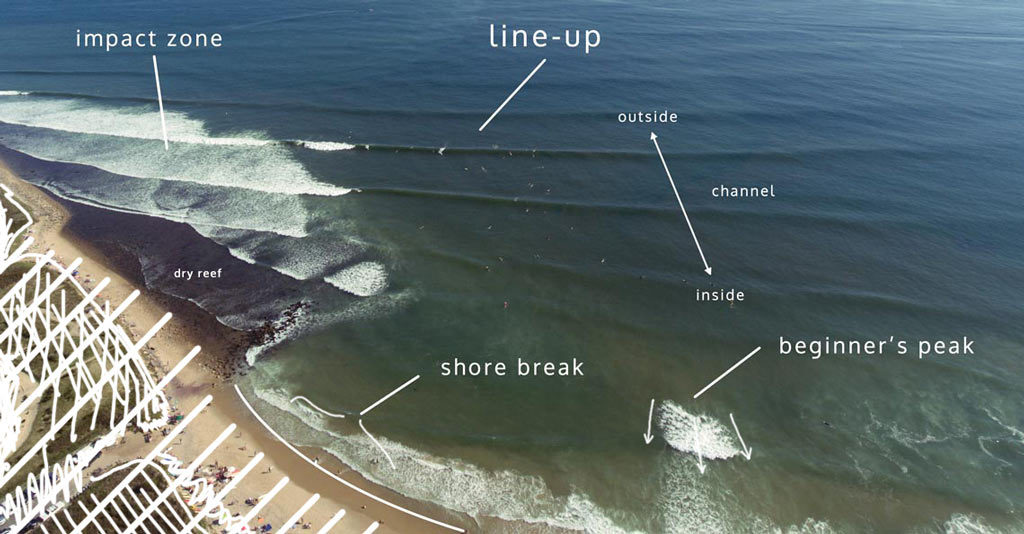
We hear this question all the time.
“I want to learn to surf, but where should I practice when I’m by myself?”
When you go to a surfing beach, the place where you see all the people surfing is almost always NOT the place you want to start learning to surf. But then where? It’s intimidating enough of an endeavor to teach yourself to surf. But now you need to find a place where there aren’t people, but is also a good place for surfing? How do you know if it’s a good spot to surf if no one is there surfing it? I understand how this can be an overwhelming request, so I want to make this easy as possible.
Completely new beginners should start where there is literally zero waves, like a bay, lake, or pond. The idea is to be somewhere you can practice your fundamentals without being required to keep your eyes on the ocean, and without worrying about how you look to other people. Trust me on this one, you’ll be better off for spending a few sessions in still water practicing your fundamentals, and it’ll pay you back ten-fold when you’re ready to move to the ocean and deal with waves and crowds.
For those with a basic proficiency in the fundamentals, going to a surfing beach (especially if it’s a beginner one) is totally acceptable, but you’ll find the most pleasure, and productive practice when you stay in the white water. Don’t attempt to paddle out to the peaking, unbroken waves unless these two conditions are in place. 1. There is no crowd. 2. the waves are waist high or less.
Last of all, after you’ve developed your fundamentals, and practiced applying them in white water, the next step is paddling out to the lineup. You still want those waves to be small, my opinion is waist high or less, but every wave is different and there are places where a waist high wave can truly rock your world.
That being said, waist high is a good rule of thumb as a maximum size wave for beginners teaching themselves. You also want to find a peak with less people on it. Beach breaks are great for this because generally there are multiple peaks up and down the beach. In such a case, you can find a peak to yourself.
Point breaks are a little different. They can be easier locations to surf in terms of reading waves, and paddling out, but those same characteristics are what also attract the crowds. Nonetheless, it’s still possible to surf a point break. Surf them when they are small and the better surfers opt out.
5. How to be Safe
Any wise individual that wants to learn to surf usually realizes that it comes with a dose of potential dangers. The ocean, surfboards, other beginners… These dangers certainly exist, but awareness is the first step to prevention. The next step is incorporating the following safety tips into your practice.
- Avoid Crowds – One of the biggest causes of injury and collision in surfing occurs when beginners surf near other surfers. I understand why it happens, when you’re a beginner you don’t know where to go and practice surfing. The most obvious place seems to be where the other surfers are. Unfortunately, this is the wrong place for a new surfer to practice. You must find a place to surf where you can be alone, or at the very least, surf where you can maintain a large safety radius around you at all times. Without a proficiency in the fundamentals, you lack the ability to call upon those simple skills to quickly and efficiently get out of the way. Additionally, it can be traumatizing to have an accident, or even a close call with another surfer, and I’ve personally met a number of people who tried surfing, and refuse to try again because they got too spooked by a bad situation with another surfer.
- Hold onto your Surfboard – The golden rule in surfing, especially for beginners. You must always do your very best to hold onto your board. Keeping your board in your hands at all times greatly minimizes the chance of being hit, or hitting others. If you find yourself constantly getting worked by the white water and losing the board from your hands, it’s time to head in and wait for smaller waves. As a beginner you should only be spending your time practicing in waves that aren’t powerful enough to rip the board from your hands. This is not to say that it will never happen to you. Losing your board happens sometimes, but ensure it is not a pattern during your session. If a pattern of losing your board when a wave hits you starts to occur, you’re in over your head. Play it safe and head to shore.
- Cover Your Head – As mentioned, sometimes you do lose control of your board. It happens. Whether you wiped out while riding a wave, or a wave ripped it out from. under you while paddling out, a good reflex to cultivate is to cover your head by intertwining your fingers behind your head, forearms should squeeze your temples, and elbows point forwards. DO NOT try to come up to the surface while the turbulence of the wave has you. Keep your head covered until the wave dissipates. This doesn’t last more than a few seconds. Stay calm underwater, and wait for the wave to dissipate.
- Stay Calm – Regardless of your skill level, there are times in surfing when you’re out of control. Stay calm. Especially when underwater. Panicking increases your oxygen consumption, and will drive you to make foolish decisions.
6. Never Turn Your Back on the Ocean
This could have been covered under safety, but it’s such an important thing to know about surfing, I decided this should be a stand alone point. I’ve witnessed many accidents in the ocean while surfing because someone wasn’t paying attention and got caught off guard. Waves can be the source of joy, and the source of pain. A person or board propelled by the energy of a wave is a scary notion. The safest way to play in the ocean is to have your eyes on it at all times.
7. The Playing Field is Dynamic
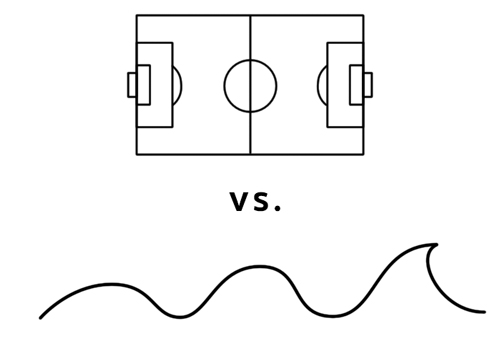
One of the most unique things about surfing is that our playing field is constantly moving.
Think about that…
How much harder would a game of soccer be if you were playing on a field that was constantly changing shape, size, angle? Throw in a moving net and you’ve got the second hardest sport in the world.
Additionally, not only is the ocean moving under you every second you spend there, but the manner in which it is moving is constantly changing. To this day I still have surf sessions where I feel so tuned in to the ocean and her movement, only to have a session the next day, or even later the same day where I lose that rhythm and it feels like I haven’t surfed in 8 months.
It can be frustrating, but learning to surf is also learning to manage your frustrations. Allow yourself to have sessions that aren’t as good as your last one; you must because it continues to happen no matter how good you get. Remind yourself that anyone who has learned to surf has dealt with these same feelings. Re-calibrate your expectations and surfing will become a much more pleasant journey.
8. There’s Surf Help Out There
Starting with The Surf Continuum. We’re dedicating a big part of our time and effort to creating high quality surf educational content. Download our free eBook and tune in to our podcast, KookCast: Surf Education, we’ll keep you tuned into the ocean on all your devices when you’re stuck on land.
If you’re motivated in a big way, finding a surf coach is one of the best ways to fast track your progress and improve quickly. We encourage people to find a coach that teaches you all aspects of surfing, especially the hard parts like paddling out and catching waves. Politely refuse any physical assistance (pushing, board holding) because that’s definitely not how any normal surfer catches waves or gets out the back.
Working with us is always an option, hit us up. We’re always moving around and teaching in different parts of the world. The other favorite option based in the New York City area would be Conatus Surf Club.
9. Surfing Mostly Sucks
Hear me out.
Since surfing is actually one of the most epic, and most rewarding things you can do, it just wouldn’t make sense for it to be totally pleasant and easy all the time, otherwise everyone could do it. And then it wouldn’t be that special. And it wouldn’t mostly suck, but it wouldn’t be that great either. You get me?
Good things in life are good because they require your hard work and perseverance to earn it. Be proud of that journey, and recognize that not everyone sticks with it, but you will.
As you continue your journey and occasionally find yourself in a place of discouragement or despair, remind yourself “surfing mostly sucks”. Proficiency is not easily reached by anyone. When you’re out surfing, and you see someone surfing better than you and making it look so easy, remind yourself again, surfing sucks for them too sometimes. Because as you get better, you put yourself in situations that are more challenging. No matter how good you get, you’ll always find someone else who does it better.
When you adjust your mentality to enjoy where you are in your journey, and remember that “surfing mostly sucks” when you’re feeling down, life gets a lot better. You’ll start to notice that you’re better than some people, just like some are better than you, and you’ll be able to continue on this long journey we call surfing…that often sucks, but is mostly epic.
Hey, at the very least it’s better than sweating it out at the gym.
